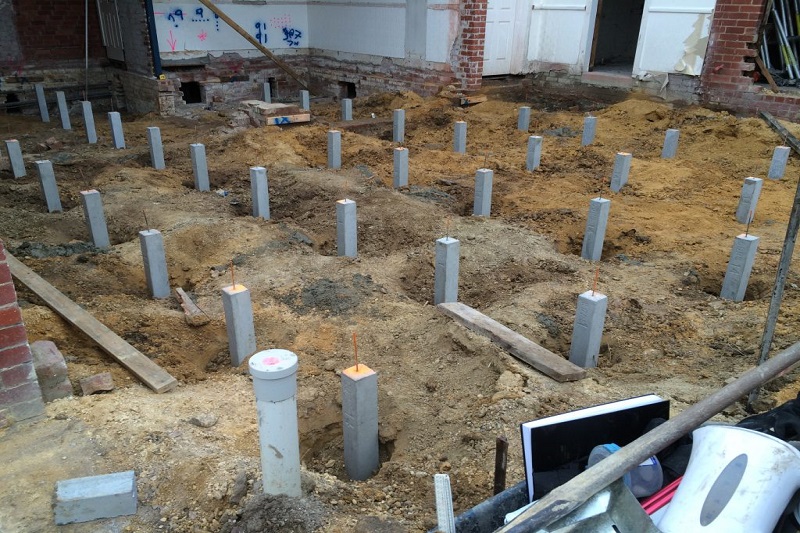The foundation plays an important role in enhancing the overall strength of the house, however, over. After a period, it may start to wear off. The underpinning foundation is the practice of restoring and strengthening building foundations. There are different ways of doing so and in this blog, we will discuss the definition of underpinning, underpinning methods, selection of underpinning methods, etc.
Sometimes something unforeseen occurs in the footing or the foundation after finishing the construction of an entire structure. In other words, mishaps in the structure above the foundation (superstructure) and below the foundation (substructure).
Therefore, it becomes crucial to use a reformatory method to restore structural integrity under such predicaments. The underpinning foundation reinforces the whole structure. The underpinning method comprises the installation of a durable help to the foundation to accomplish balance and bearing strength.
It gets its name from excavating the soil, which runs in separate phases called pins. Regardless of the underpinning method chosen for strengthening the footing, they all adhere to laying the base over a robust soil layer. The method selection is based on the foundation depth requirement and ground conditions.
Underpinning methods/practices
- Mass concrete underpinning is the conventional practice of underpinning and has been followed for hundreds of years. This method extends the old foundation until it arrives at a stable soil layer. After that, dig the soil carefully through different pins or phases.
- Before initiating the next excavation phase, they fill the excavation with concrete once they reach the befitting soil layer. Afterwards, you yield a new pin by setting down dry sand-cement mortar to shift the load to a new foundation. This is a cost-efficient method conducive to shallow foundations.
- The Cantilever pit method is an augmentation of the pit method. Use this method when the layout comprises a firm interior column and you must extend the foundation only to one side.
Pros of the Cantilever Needle Beam Method
- Efficient than the conventional method
- Only one side access
- High bearing capacity
Cons
- When the foundation is deep, then digging becomes uneconomical
- Lack of flexibility in using the needle beams
Pier and beam underpinning method
These were executed during post second world war. This method gained ground because the mass concrete method was not suitable for an extensively deep foundation. As a result, they set reinforced concrete beams to shift the load to mass concrete piers or bases. The applied loads and the ground conditions determine the profundity and magnitude of the beams. The suitable profundity has a lesser depth than 6.0 m.
They implement the mini pile method when the loads from the footing must be shifted to the substratum stationed at more than 5m. This method is suitable when working on unpredictable soil. Besides, it has limited access and gives rise to environmental pollution.
In the pile method of underpinning, you drive the piles on the abutting sides of the wall, supporting the weak footing. Further, a pin or needle drills the wall linked to the piles. These pins act like pile caps. This method helps treat soil’s downward movement due to its clayey nature or water clogging.
Substitutes to Underpinning
We saw in the above points that underpinning is related to the reinforcement of the footings of a structure. On the contrary, its alternatives aim to reinforce the soil.
- Mud jacking – This method raises the concrete by bloating chemicals under it through drilled cavities. The force of the expanding muck elevates the concrete.
- Ground injection – This method involves pumping the cement directly into the soil, transforming the chemical structure to reduce its greasiness. They insert a sleeve port pipe into a drilled hole and pump chemicals via this pipe.
Still, these are neither as effective as the underpinning foundation methods nor do they ensure a durable solution for any foundation. Hence, it is better to opt for the route that ensures endurance.

Why do we need underpinning methods?
People might need to do the Underpinning foundation due to the downward movement of the soil. In other words, you need to do underpinning to prevent your house from sinking further. So,
- It prevents your money from sinking into methods such as ground injection, mud jacking, etc.
- It ensures a considerable return on investment.
- Solution for degradation of hardwood foundation, which causes footing settlement.
- Buildings or other structures standing over soil strata that lack load-bearing capacity need underpinning for durability.
- Variability of the water table can reduce the load bearing of soil. Hence, underpinning foundation methods are needed to prevent the structure from sinking.
Closing thoughts
The Underpinning foundation is a long-term solution for massive investments such as houses. Investing in the current structure is better to avoid the expenses of constructing another one.